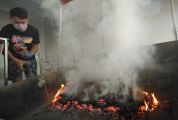 PDF(1786 KB)
PDF(1786 KB)


 PDF(1786 KB)
PDF(1786 KB)
 PDF(1786 KB)
PDF(1786 KB)
昆明西山林场5种可燃物的火行为研究
Fire behavior of five kinds of fuels in Xishan Forest Farm, Kunming City
 ,
,
【目的】通过估测西山林场内主要可燃物特征,预测潜在的火行为大小,为西山林场的防火管理提供科学参考。【方法】通过外业调查,对柏木(Cupressus funebris)、旱冬瓜(Alnus nepalensis)、云南松(Pinus yunnanensis)、华山松(P. armandii)和麻栎(Quercus acutissima)5种可燃物采样,估算西山林场内主要可燃物载量大小,并在实验室内进行燃烧模拟试验,量化火行为特征,包括引燃时间、火焰维持时间、无焰燃烧维持时间、蔓延时间、火焰高度、火焰温度、无焰燃烧温度、火焰热辐射、无焰燃烧热辐射等。【结果】云南松林内的载量达到2.35 kg/m2、燃烧火焰最高温度628 ℃、燃烧火焰最大高度70 cm、最大热辐射为6.92 kW/m2、燃烧后无焰燃烧的最高温度266 ℃,均与每年进行计划烧除时云南松纯林内的载量1.15 kg/m2、火焰最高温度697.6 ℃、火焰最大高度44.5 cm、最大热辐射8.02 kW/m2,无焰燃烧的最高温度194.3 ℃有差异。不同林种可燃物的火强度大小依次为:云南松(786.07 kW/m) >麻栎(564.39 kW/m)>华山松(275.30 kW/m) >柏木(6.26 kW/m),其中云南松的火强度(786.07 kW/m,中强度火)与云南松纯林计划烧除时的火强度403.60 kW/m(低强度火)有差异。【结论】森林可燃物的载量对火强度影响较大,麻栎和华山松属于低强度火,柏木的火强度几乎可以忽略不计。森林抚育更新等人为干预措施,可对林内可燃物进行有效调控,减少和预防森林火灾的发生。
【Objective】 This study aimed to improve fire prevention management for Xishan Forest Farm by estimating the main fuels characteristics and predicting potential fire behavior. 【Method】 Based on a field survey and sampling, the status of fuel was analyzed in the Xishan Afforestation Community. There were five main types of combustibles: Cupressus funebris, Alnus nepalensis, Pinus yunnanensis, P. armandii, and Quercus acutissima. Their combustion was measured in the laboratory, and the fire behavior was calculated, including ignition time, flame maintenance time, flameless combustion maintenance time, spread time, flame height, flame temperature, flameless combustion temperature, flame heat radiation and flameless combustion heat radiation. 【Result】 In the P. yunnanensis forest, the fuel load was 2.35 kg / m2, the maximum flame temperature was 628 ℃, the maximum flame height was 70 cm, the maximum flame heat radiation was 6.92 kW / m2, and the maximum temperature for flameless combustion was 266 ℃. During the prescribed burning every year in P. yunnanensis, the load was 1.15 kg / m2, the highest temperature of the flame was 697.6 ℃, the maximum flame height was 44.5 cm, the maximum heat radiation of the flame was 8.02 kW/m2, and the maximum temperature for flameless combustion was 194.3 ℃. There was a difference between the prescribed burning and Xishan forest farm of P. yunnanensis. The fire intensity order was P. yunnanensis > Q. acutissima > P. armandii > C. funebris, and the intensity values were 786.07, 564.39, 275.30 and 6.26 kW/m, respectively. Among these, the fire intensity of P. yunnanensis of 786.07 kW/m (medium-intensity fire) was different from the fire intensity of 403.60 kW / m (low-intensity fire) when P. yunnanensis of pure forest is planned to be burned. 【Conclusion】 The fuel load had the greatest impact on the fire intensity of combustibles. Q. acutissima and P. armandii were low-intensity fires, and the fire intensity of C. funebris was almost negligible. It is recommended that the Xishan Afforestation Community adopt human intervention to effectively treat forest combustibles and to prevent forest fires.

有焰燃烧 / 无焰燃烧 / 火强度 / 阻滞时间 / 地表可燃物 / 昆明市西山林场
flaming combustion / flameless combustion / fire intensity / residence time / surface fuel / Xishan Forest Farm of Kunming City
| [1] |
孙武, 牛树奎. 北京地区主要针叶林型林火行为[J]. 东北林业大学学报, 2012,40(2):54-60.
|
| [2] |
胡海清, 罗斯生, 罗碧珍, 等. 林火干扰对广东马尾松林土壤有机碳密度及其活性有机碳的影响[J]. 南京林业大学学报(自然科学版): 2020,44(5):132-140.
|
| [3] |
罗碧珍, 罗斯生, 魏书精, 等. 生物质燃烧排放物研究进展[J]. 南京林业大学学报(自然科学版), 2018,42(6):191-196.
|
| [4] |
田晓瑞, 王明玉, 殷丽, 等. 大兴安岭南部春季火行为特征及可燃物消耗[J]. 林业科学, 2009,45(3):90-95.
|
| [5] |
潘登, 张合平, 潘高, 等. 桂西南松栎林火行为研究及碳排放计量[J]. 自然灾害学报, 2017,26(5):51-61.
|
| [6] |
张家来, 曾祥福, 胡仁华, 等. 湖北主要森林可燃物类型及潜在火行为研究[J]. 华中农业大学学报, 2002,21(6):550-554.
|
| [7] |
陈帅, 陶骏骏, 王振师, 等. 火行为对森林地表可燃物燃烧碳转化的影响[J]. 燃烧科学与技术, 2018,24(2):177-185.
|
| [8] |
潘登, 张合平, 潘高, 等. 基于Rothermel的南亚热带马尾松人工林潜在火行为研究[J]. 中南林业科技大学学报, 2017,37(6):14-23.
|
| [9] |
陈启良, 刘清江, 王秋华, 等. 昆明地区冲天柏林地表可燃物特征及火行为研究[J]. 林业调查规划, 2018,43(5):64-69.
|
| [10] |
张景群, 康永祥, 吴宽让, 等. 秦岭森林潜在火行为数量分类及划分指标研究[J]. 林业科学, 2001,37(1):101-106.
|
| [11] |
张敏, 刘东明. 长白山林区落叶松林可燃物模型及火行为状况[J]. 自然灾害学报, 2007,16(2):127-132.
|
| [12] |
张吉利, 刘礴霏, 邸雪颖, 等. 平地无风条件下蒙古栎阔叶床层的火行为Ⅲ.火线强度、可燃物消耗和燃烧效率分析及预测模型[J]. 应用生态学报, 2013,24(12):3381-3390.
|
| [13] |
王秋华, 仝艳民, 李世友, 等. 滇中地区入侵紫茎泽兰的潜在火行为[J]. 福建林业科技, 2015,42(2):29-33.
|
| [14] |
蔡卫红, 王晓红, 于宏洲, 等. 基于Rothermel模型的可燃物参数对林火行为影响的计算机仿真[J]. 中南林业科技大学学报, 2013,33(11):34-41.
|
| [15] |
金森, 周勇. 昆明典型地表死可燃物含水率预测模型的研究[J]. 中南林业科技大学学报, 2014,34(12):7-15.
|
| [16] |
吴志伟, 贺红士, 梁宇, 等. 丰林自然保护区森林可燃物模型的建立[J]. 应用生态学报, 2012,23(6):1503-1510.
|
| [17] |
胡海清, 陆昕, 孙龙, 等. 大兴安岭典型林分地表死可燃物含水率动态变化及预测模型[J]. 应用生态学报, 2016,27(7):2212-2224.
|
| [18] |
刘方策, 张运林, 满子源, 等. 照片分类法与图像识别技术相结合的森林可燃物分类[J]. 东北林业大学学报, 2018,46(11):51-57.
|
| [19] |
于宏洲, 金森, 邸雪颖. 以时为步长的塔河林业局白桦林地表死可燃物含水率预测方法[J]. 林业科学, 2013,49(12):108-113.
|
| [20] |
孙龙, 鲁佳宇, 魏书精, 等. 森林可燃物载量估测方法研究进展[J]. 森林工程, 2013,29(2):26-31,37.
|
| [21] |
杨博文, 陈鹏宇, 金森. 帽儿山两林分气温与地表可燃物温度差异及对可燃物含水率预测的影响[J]. 林业科学, 2015,51(7):91-98.
|
| [22] |
吴志伟, 贺红士, 刘晓梅, 等. 丰林保护区地表森林死可燃物载量与环境因子的关系[J]. 东北林业大学学报, 2011,39(3):52-55.
|
| [23] |
陈宏伟, 常禹, 胡远满, 等. 大兴安岭呼中林区森林死可燃物载量及其影响因子[J]. 生态学杂志, 2008,27(1):50-55.
|
| [24] |
|
| [25] |
|
| [26] |
|
| [27] |
|
| [28] |
|
| [29] |
|
| [30] |
骆介禹. 森林燃烧能量学[M]. 哈尔滨: 东北林业大学出版社, 1992.
|
| [31] |
王秋华, 单保君, 龚家平, 等. 滇中地区云南松纯林计划烧除研究[J]. 江西农业大学学报(自然科学版), 2018,40(2):235-240.
|
| [32] |
王秋华, 刘文国, 李世友, 等. 昆明西山国家森林公园粗死木质残体的燃烧性研究[J]. 江西农业大学学报(自然科学版), 2013,35(1):138-143.
|
/
| 〈 |
|
〉 |